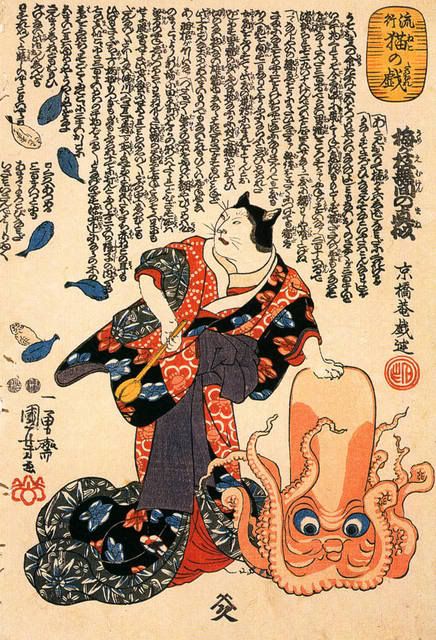This blog will be dedicated to the art and influence of Utagawa Kuniyoshi.
The following is an excerpt from http://www.kuniyoshiproject.com/
The man who was to be known to history as Utagawa Kuniyoshi was born in Edo (present-day Tokyo) in 1797. He was the son of a silk dyer named Yanagiya Kichiemon and was given the name Yoshisaburô. At the age of 14, Yoshisaburô joined the Utagawa School of ukiyo-e artists, then headed by Utagawa Toyokuni I (1769 - 1825). Toyokuni I gave Yoshisaburô the name Utagawa Kuniyoshi, Kuniyoshi being a combination of Toyokuni and Yoshisaburô.
In 1814, Kuniyoshi ended his apprenticeship and set out as an independent artist. He initially produced actor prints in the style of his teacher, which gained him little recognition. Kuniyoshi achieved a commercial and artistic breakthrough in 1827 with the first six designs of the series, The 108 Heroes of the Suikoden. The series was bases upon a 14th century Chinese novel about the adventures of a band of 108 honorable bandits and rebels.
Like his teacher, Kuniyoshi had many students including Yoshitoshi, Yoshi’iku, Yoshikazu, Yoshitsuya, Yoshiyuki, Yoshifuji, Yoshifusa, Yoshiharu, Yoshikage, Yoshikata, Yoshikatsu, Yoshimori, Yoshimune, Yoshinao*, Yoshinobu*, Yoshitoyo*, Yoshitsuna, Kyôsai (briefly) and his own daughters, Yoshitora and Yoshitori. Kuniyoshi had a special fondness for cats, which overran his studio and are portrayed in many of his prints.
Although Kuniyoshi is now universally known as Utagawa Kuniyoshi, he also used the names Ichiyûsai Kuniyoshi, Chô-ô-rô Kuniyoshi, Igusa Kuniyoshi, Ichi Kuniyoshi and Saihôsa Kuniyoshi. He died from complications of a stroke on April 14, 1861.
____________
*These names were used by print artists in the city of Ôsaka as well as by the Edo artists who studied with Kuniyoshi.
Shown below:
Title: Umegae mugen no mane (Japanese) *not dated
Description: A parody (mitate) of a scene in the fourth act of the kabuki play, Simple Chronicle of the Fortunes of the Heike and Genji (Hiragana seisuiki). In the play, Genta Kagesue strikes a stone water basin and is showered with gold coins, which are thrown by his concealed mother.







No comments:
Post a Comment